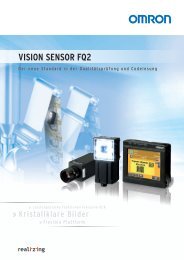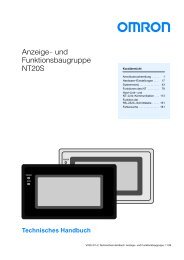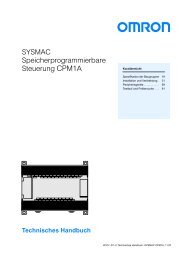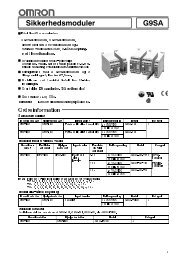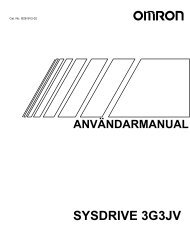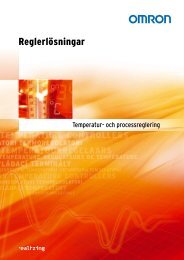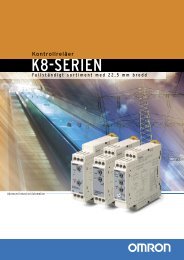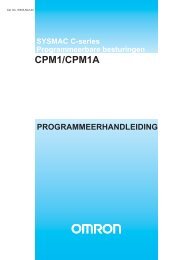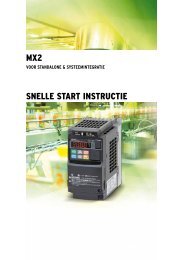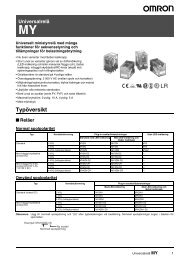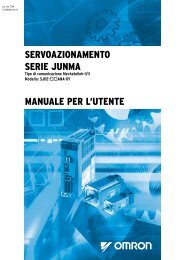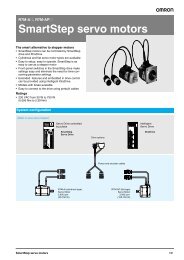Motion & Drives - Servo Systems - Omron Europe
Motion & Drives - Servo Systems - Omron Europe
Motion & Drives - Servo Systems - Omron Europe
You also want an ePaper? Increase the reach of your titles
YUMPU automatically turns print PDFs into web optimized ePapers that Google loves.
Doc No APTJ002-EN-01<br />
Vertical Form Fill and Seal Machine<br />
Automated with next <strong>Omron</strong> products<br />
Model:<br />
R88D-KN[][][]-ECT <strong>Servo</strong>drive<br />
TJ2-MC64 <strong>Motion</strong> controller<br />
MX2A[][][][]-E Inverter<br />
APPLICATION NOTE
<strong>Omron</strong> AT-WEST<br />
Application Notes<br />
1. INTRODUCTION<br />
CONTENTS<br />
2. MACHINE OVERVIEW: The vertical form fill & seal machine<br />
a. Which kind of package.<br />
b. The machine general description.<br />
c. The necessities and requirements for the motion control<br />
d. The <strong>Omron</strong> solution with TJ2-MC04<br />
i. General overview of the solution<br />
ii. How the <strong>Omron</strong> solution match the machine requirements.<br />
iii. Part list and details about the products.<br />
3. MACHINE SECTIONS: Detailed description.<br />
a. The filler.<br />
i. Description and technical issues.<br />
ii. How to solve this with <strong>Omron</strong>.<br />
b. The feeder and vertical sealer.<br />
i. Description and technical issues.<br />
ii. How to solve this with <strong>Omron</strong>.<br />
c. The horizontal sealer.<br />
i. Description and technical issues.<br />
ii. How to solve this with <strong>Omron</strong>.<br />
d. The unwinder. Optional device<br />
i. Description and technical issues.<br />
ii. How to solve this with <strong>Omron</strong>.<br />
4. THE MACHINE OPERATION. State diagram and user interface.<br />
5. SUMMARY AND CONCLUSION.<br />
Vertical Form fill and seal machine Page 2 of 33 Preliminary Version
<strong>Omron</strong> AT-WEST<br />
Application Notes<br />
Vertical Form fill and seal machine Page 3 of 33 Preliminary Version
<strong>Omron</strong> AT-WEST<br />
Application Notes<br />
1. INTRODUCTION<br />
The purpose of this document is to provide a description about how a typical<br />
intermittent motion vertical form fill and seal machine operates, to describe the main<br />
functional operations of the machine and the solution and it s alternatives when there<br />
is more than one.<br />
Later it is explained how <strong>Omron</strong> can meet the requirements and offer a solution that<br />
fits the application.<br />
Every part of the machine is discussed in det ail, it is explained the operation itself<br />
and how to program this operation with the <strong>Omron</strong> solution. Some example<br />
programs are provided too so, this document is a useful tool to help both, to select<br />
the suitable <strong>Omron</strong> products according to your machine, and to program the<br />
products as the main subroutines are pre-made.<br />
Vertical Form fill and seal machine Page 4 of 33 Preliminary Version
<strong>Omron</strong> AT-WEST<br />
Application Notes<br />
2. MACHINE OVERVIEW<br />
a. Which kind of goods is packaging.<br />
The vertical form fill and seal machine is designed to pack:<br />
- Liquid or other viscous products like juice, soap, toothpaste,<br />
beauty cream, and other.<br />
- Powder products like washing powder, flour, etc.<br />
- Small solid goods: Sweets, chips, etc.<br />
The pack is a soft plastic bag made from a roll of plastic film. See some<br />
examples in the picture:<br />
Fig. 1<br />
Due to the nature of the goods to be packed, the machine is designed<br />
to fill the product in the vertical direction so the products are falling into<br />
the bag by gravity.<br />
b. The machine general description.<br />
Although there are many variations and every machine has differences<br />
from another one due to the OEM technology, the packaging material<br />
and the goods to be packed, we can say that the vertical form fill and<br />
seal is one of the most standard ones in the packaging market.<br />
Here you can see a general diagram of a typical machine:<br />
Vertical Form fill and seal machine Page 5 of 33 Preliminary Version
<strong>Omron</strong> AT-WEST<br />
Application Notes<br />
FILLER<br />
(Auger type)<br />
External encoder<br />
for slip<br />
compensation<br />
E<br />
FEEDER<br />
Some parts of the machine are a must; some other varies depending<br />
on the material used in the bags and on the goods to be packed.<br />
BRIEF DESCRIPTION:<br />
The bag material comes from a plastic film coil that is unwound. This<br />
plastic film is shaped into a tube by a mechanical mandrel while it is<br />
feed, at the same time, the plastic tube is sealed vertically.<br />
The feed movement is intermittent and the feed length corresponds<br />
with the bag length. Once the bag is fed, the horizontal sealer closes<br />
the bag an d it is filledw with the product. After that, the process starts<br />
again feeding a new bag.<br />
THE FEEDER<br />
Vertical<br />
sealer<br />
Registration<br />
mark<br />
HORIZONTAL<br />
SEALER<br />
* * *<br />
Dancer (10V<br />
reference)<br />
Sensor for<br />
empty coil<br />
UNWINDER<br />
The heart of the machine is the film feeder. This axis consists of a<br />
servomotor attached to some chain that feeds the plastic film to a<br />
certain length, that is the bag length . If the plastic bag is transparent or<br />
does not have a fixed printed pattern, the movement is just a simple point-<br />
to-point movement, but if the bag has a defined pattern that you must<br />
respect (and this is the most usual case), it is necessary to make the<br />
movement adding a correction based in a printed mark.<br />
Vertical Form fill and seal machine Page 6 of 33 Preliminary Version<br />
Fig. 2
<strong>Omron</strong> AT-WEST<br />
Application Notes<br />
Without Mark<br />
With Mark<br />
Detail of a<br />
Mark<br />
Fig. 3<br />
Most of the machines have the option to work with mark and without<br />
mark.<br />
Another important topic to consider regarding the feeder is the slip of<br />
the plastic film: In some conditions, the plastic film slips over the feeder<br />
belts so, the movement of the feeder is longer than the real plastic film<br />
movement (e.g. The feeder moves 200mm but the plastic just 190mm).<br />
If this slip is small can be neglected (or corrected if we are using<br />
registration) but if this slip is big it can create problems in the precision<br />
of the bag.<br />
The slip depends on several factors as:<br />
- The adherence to the material to be fed.<br />
- The weight of the material to be feed (especially if the<br />
machine has no unwinder system).<br />
- The speed and acceleration of the machine.<br />
The solution to avoid the slip is to add an external encoder that<br />
measures the real movement of the plastic. This is an optional element<br />
that not all the machines have.<br />
* * *<br />
THE FORMING HEAD AND SIDE-SEAL<br />
The bag material is a flat plastic sheet. To form the bag this flat sheet<br />
must be shaped into a tube and side-sealed.<br />
The tube is formed while the material is feed because the film is driven<br />
through a mandrel with a specific shape.<br />
Vertical Form fill and seal machine Page 7 of 33 Preliminary Version
<strong>Omron</strong> AT-WEST<br />
Application Notes<br />
The side sealing is done usually via two sealing heads heated at a<br />
certain temperature. While the material is feed the sides of the plastic<br />
tube<br />
passes through the sealer and makes the closed tube.<br />
There is a mechanism that stops the sealing to avoid that the plastic<br />
burns when the feeder is stopped due to excessive heating.<br />
One of the<br />
systems<br />
is a small valve activated by a digital output<br />
THE<br />
HORIZONTAL SEALER<br />
* * *<br />
The horizontal sealer consists on two heated jaws. Those jaws may be<br />
driven by a piston in the more simple machines or may be driven by a<br />
servomotor when more precise control of the movement and timings is<br />
required. This movement is performed after the feed movement, when<br />
the<br />
bag tube is stopped.<br />
It is a simple “Open-close” point-to-point movement.<br />
The same movement seals the top of the previous bag and the bottom<br />
of the current one and can, optionally, cut the bag. There is different<br />
physical construction<br />
of the seal jaws, but the principle of operation is<br />
always<br />
the same.<br />
THE<br />
FILLER<br />
* * *<br />
The filler varies a lot depending on the material to fill. In fact, in some<br />
cases it is considered as a separate machine. For products consisting<br />
in small pieces like sweets or chips it is normal to weight and to dose,<br />
for liquid products is more common a valve and a caudalimeter and,<br />
for<br />
powder<br />
and viscous material it is used the so called “Auger filler”.<br />
The Auger filler consist in a tool with screw-like shape driven by a<br />
servomotor. The volume of product is proportional to the movement of<br />
the<br />
screw.<br />
In case of the Auger fillers, the movement is a point-to-point<br />
movement<br />
that<br />
is performed just after the jaw sealer has been closed.<br />
THE<br />
UNWINDER<br />
* * *<br />
One optional device is the unwinder. For the smaller machines, the<br />
feeder movement is, at the same time, unwinding the plastic from the<br />
coil. But this system is valid if the plastic coil is not very big and the<br />
Vertical Form fill and seal machine Page 8 of 33 Preliminary Version
<strong>Omron</strong> AT-WEST<br />
Application Notes<br />
plastic is rather rigid so, it is not deformed by excessive tension during<br />
the acceleration. Usually it exists some kind of accumulator system.<br />
For bigger plastic coils and delicate material it is usual to have some<br />
kind of unwinding system and a material accumulator. Those unwinding<br />
systems tend to be very simple as no precision is required. Nor mally it<br />
uses an AC motor with a frequency inverter.<br />
The most common way to unwind is with an inverter and a PID system<br />
where the reference is a fixed value and the feedback is an analogue<br />
signal coming from a dancer arm in the accumulator.<br />
SPECIFICATION EXAMPLE:<br />
* * *<br />
A typical specification of a vertical form fill and seal machine can be as<br />
it is shown in the table below:<br />
ITEM VALUE<br />
Bag Width 50 mm minimum up to 380 mm maximum<br />
Bag Length 100 mm minimum up to 550 mm maximum<br />
Machine Speed 12 bag/min minimum up to 100 bags/min maximum<br />
Power Requirements 220-240Vac single phase, 30 A<br />
Film Width 800 mm<br />
Maximum Roll Diameter 600 mm<br />
Machine Finish Stainless Steel<br />
Machine dimensions 1950mm L x 1250 mm W x 1450 mm H<br />
c. The necessities and requirements for the motion control.<br />
The machine consist basically in three axes driven by servomotors:<br />
- The feeder.<br />
- The side sealer<br />
- The filler (considering an Auger-Type)<br />
The unwinder, if it exists, is usually one inverter with an embedded PID.<br />
The PID is executed in the inv erter and the setpoint is set from <strong>Motion</strong><br />
controller (although it tend to be a fixed value). In moderns systems,<br />
inverter are controlled in similar way to servos using a common<br />
motion bus.<br />
The movements of the machine are basically point-to-point sequential<br />
movements, that is, every axis makes an independent movement but<br />
one movement in one axis cannot start until the previous movement in<br />
the sequence has not finished.<br />
Vertical Form fill and seal machine Page 9 of 33 Preliminary Version
<strong>Omron</strong> AT-WEST<br />
Application Notes<br />
The next diagram shows the sequence of a complete cycle:<br />
Fig. 4<br />
Film Feeder<br />
Speed<br />
Filler Speed<br />
Unwinder<br />
speed<br />
Registration Registration<br />
Horizontal<br />
Seal Speed Time to seal bag<br />
1 BAG<br />
Time<br />
Time<br />
Time<br />
Time<br />
The feeder needs a point to point position control with the possibility of<br />
a printed mark correction and the possibility to have an external<br />
encoder for the real positioning.<br />
The horizontal sealer is just a point-to-point positioner with two<br />
absolute positions.<br />
The Auger filler needs a point-to-point incremental positioner. The<br />
incremental position needs to be adjustable.<br />
d. The <strong>Omron</strong> solution with TJ2-MC04<br />
- General overview of the solution.<br />
Vertical Form fill and seal machine Page 10 of 33 Preliminary Version<br />
T<br />
This is the proposed <strong>Omron</strong> solution for the vertical form fill and seal<br />
machines.
<strong>Omron</strong> AT-WEST<br />
Application Notes<br />
G5-ETHERCAT<br />
FILLER<br />
G5-ETHERCAT<br />
FEEDER<br />
G5-ETHERCAT<br />
SEALER<br />
Fig. 5<br />
NS5-SQ11B-V2<br />
FILLER<br />
Registration<br />
mark<br />
slip E<br />
compensatio<br />
ETHERNET<br />
FINS<br />
FEEDER<br />
ETHERCAT<br />
Sensor for<br />
Empty coil<br />
HORIZONTAL<br />
SEALER<br />
UNWINDER<br />
Dancer<br />
TJ2MC64+TJ2-<br />
ECT04<br />
MX2+3G3AX-<br />
MX2-ECT<br />
UNWINDER<br />
The proposed solution is based on the TJ2-MC64 motion controller with<br />
the TJ2-ECT04 EtherCAT Master. The filler, feeder and sealer will be<br />
driven by G5 servodrives with EtherCAT interface and the unwinder will<br />
be a MX2 Inverter, also with EtherCAT option board.<br />
For this document we will assume that the embedded digital inputs and<br />
outputs in the TJ2-MC04 are sufficient for the machine. If more inputs<br />
or outputs are necessary, those can be added to the EtherCAT network<br />
by using the <strong>Omron</strong> slice IO’s and the EtherCAT interface (GRT1-ECT).<br />
- How <strong>Omron</strong> solution match the machine requirements.<br />
The solution based in TJ2-MC64 match perfectly the machine<br />
requirements.<br />
Regarding the performance, the TJ2-MC64 can execute the necessary<br />
movements and supports registration correction (executed in the<br />
servodrive) and external encoder connection (also connected directly<br />
to the servodrive).<br />
Vertical Form fill and seal machine Page 11 of 33 Preliminary Version
<strong>Omron</strong> AT-WEST<br />
Application Notes<br />
TJ2-MC64 can also handle the sequence of the machine. It is<br />
programmed in a dedicated multi-tasking basic-like programming<br />
language with advanced high-level motion commands.<br />
The TJ2-MC64 controls the servomotors using the high performance<br />
EtherCAT motion bus. EtherCAT sends cyclicaly and deterministically<br />
the position reference to the servodrives. The system dramatically<br />
reduces the wiring of the machine because the connections to the<br />
servodrives is done by using cheap and widely available standard<br />
Ethernet cables (Category 5 or higher). That reduces cost of cables<br />
and installation manpower compared with the traditional pulse or<br />
analogue solutions. In addition, EtherCAT adds additional performance<br />
as you can access to all drive features from a single connection point,<br />
including read/write parameters, tuning, trace, diagnostics, etc.<br />
The inverter also is connected to the same EtherCAT network and is<br />
handled in the same way than a servodrive (in speed control in this<br />
case), this simplifies also the wiring and the engineering hours.<br />
If more I/O’s are needed, they also can be connected to the EtherCAT<br />
network. For this we will use the Slice IO’s and the EtherCAT coupler:<br />
GRT1-ECT.<br />
The ACCURAX G5 servodrives with embedded EtherCAT interface<br />
(R88D-KNxxxx-ECT) controls the servomotor. The position loop is<br />
performed in the servodrive so, it is quick and independent on the<br />
number of axes. Besides, it has registration input and connection for<br />
the external encoder for the slip compensation. All this without<br />
additional boards.<br />
ACCURAX G5 is the servo with the highest bandwidth (faster dynamic<br />
response) in the market (at January 2011).<br />
The servodrives also have embedded Safety (STO) to match the safety<br />
regulations in a simple way. Up to 8 servodrives can be connected to a<br />
single safety relay.<br />
The MX2 Inverter, with the EtherCAT interface module has an<br />
embedded PID that is used to control the unwinder so, the motion<br />
controller simply gives the PID reference and the sequence commands<br />
(run, stop, reset, …) via EtherCAT.<br />
The user interface typically is an NS touch screen HMI that provides a<br />
friendly graphic and intuitive environment to the machine operator.<br />
Besides we can make all the necessary machine adjustments, have a<br />
complete diagnostics and make all the operations from this single<br />
point. The HMI is connected to the TJ2-MC64 via Ethernet (FINS<br />
protocol) or via serial (Hostlink protocol).<br />
Vertical Form fill and seal machine Page 12 of 33 Preliminary Version
<strong>Omron</strong> AT-WEST<br />
Application Notes<br />
TJ2-MC04 also provides several Ethernet protocols that can be used<br />
for different purposes like, connectivity with an upper controller, remote<br />
programmability, etc. It is possible to connect Trajexia to a LAN or to<br />
the Internet to have worldwide access to it.<br />
- Part list and details about the products:<br />
MOTION CONTROLLER<br />
1x TJ2-MC64 <strong>Motion</strong> controller<br />
1x TJ2-ECT04 EtherCAT Master<br />
1x CJ1W-PA202 Power supply<br />
SERVO SYSTEM<br />
3x R88M-K75030H-S2 750W, 3000rpm servomotor<br />
3x R88D-KN08H-ECT 800W, EtherCAT servodrive<br />
3x R88A-CAKA005SR-E Motor power cable<br />
3x R88A-CRKA005CR-E Motor encoder cable<br />
3x R88A-FIK107-RE Filters<br />
1x R88A-CNW01C IO connector (to connect the<br />
registration)<br />
3x R88A-CSK003S-E Safety connector cable (3m)<br />
INVERTER<br />
1x 3G3MX2-AB007 MX2 Inverter 1.1KW<br />
1x 3G3AX-MX2-ECT EtherCAT interface<br />
HMI<br />
1x N25-SQ11B-V2 HMI with EtherCAT<br />
OTHER<br />
1x E3M-VG16 Fast photocell for registration<br />
1x G9SB-2002A-24V Safety relay<br />
Vertical Form fill and seal machine Page 13 of 33 Preliminary Version
<strong>Omron</strong> AT-WEST<br />
Application Notes<br />
3. MACHINE SECTIONS.<br />
In this section it is described in detail the different sections of the machine and<br />
the way of solving it with the <strong>Omron</strong> products. It includes technical description<br />
of the different topics and references to the different program examples.<br />
a. The filler:<br />
We consider here Auger filler. The distance to move is proportional to<br />
the product volume t o be feed. This data is a variable that the user<br />
enters via the HMI. To<br />
simplify the interface with<br />
the machine operator it is<br />
very convenient to use<br />
recipes in the HMI. The<br />
operator enters, for<br />
example “bag of 250g salt”,<br />
and the HMI sends to the<br />
PLC all the set of<br />
necessary data, not just for<br />
the filler but also for the<br />
complete machine.<br />
The condition to start the<br />
movement is that the<br />
horizontal sealer has<br />
Fig. 6<br />
closed the bag.<br />
When the movement has finished it must start the feeder movement to<br />
feed a new bag.<br />
Filler Speed<br />
Sealer Closed<br />
Filling in process<br />
Time<br />
Vertical Form fill and seal machine Page 14 of 33 Preliminary Version<br />
Fig. 7<br />
Note: in this entire document we will draw the speed time curve because it is<br />
easier to visualize but the commands we give are POSITION. The position in<br />
this graph is the area below the speed curve.
<strong>Omron</strong> AT-WEST<br />
Application Notes<br />
With the TJ2-MC04 the program is as simple as a MOVE function (see<br />
the program example below).<br />
'...<br />
IF VR(mode)=automatic THEN<br />
'...<br />
WAIT IDLE AXIS(sealer)<br />
MOVE(VR(fill_amount)) AXIS(filler)<br />
WAIT IDLE AXIS(filler)<br />
'...<br />
ENDIF<br />
'...<br />
The variables grouped as VR(name) are global variables that may be<br />
changed via the HMI. Those variables can be changed and applied on<br />
the fly, depending on the way the program is written.<br />
The command IDLE AXIS(name) indicates if one axis is in movement<br />
or not, this is used to control the sequence of the movements. No flags<br />
are necessary, simplifying the program.<br />
TECHNICAL HINT<br />
In some Auger fillers for viscous materials like toothpaste, they combine<br />
a fill movement and, after that, a sm all movement backwards to remove<br />
the last “drop” and avoid product accumulation in the dosifier.<br />
Vertical Form fill and seal machine Page 15 of 33 Preliminary Version
<strong>Omron</strong> AT-WEST<br />
Application Notes<br />
b. The feeder and vertical sealer<br />
The feeder has two working modes: Wi thout registration mark and with<br />
registration mark.<br />
Working without registration mark is a simple point-to-point incremental<br />
movement.<br />
Working with<br />
registration mark, the<br />
motion controller<br />
executes a movement<br />
to a certain position. If<br />
during the positioning<br />
the registration mark<br />
is detected, the target<br />
position is changed on<br />
the fly in order to finish<br />
the movement at a<br />
defined position<br />
after the mark.<br />
It is wise to order the<br />
movement to a<br />
position that is the<br />
theoretical bag length<br />
so the correction is<br />
very small during<br />
normal operation.<br />
Feeder speed<br />
1- The rising edge<br />
of the registration<br />
captures the<br />
feeder position<br />
Mandrel for<br />
bag forming<br />
Vertical<br />
sealer<br />
External encoder<br />
for slip<br />
compensation<br />
Vertical Form fill and seal machine Page 16 of 33 Preliminary Version<br />
E<br />
Feeder<br />
Printed mark<br />
Mark sensor<br />
Fig. 8<br />
2- The new target position is recalculated:<br />
TARGET POS= CAPTURED POS+”D”<br />
The area below<br />
the graph<br />
(distance) is “D”<br />
Time<br />
Fig. 9
<strong>Omron</strong> AT-WEST<br />
Application Notes<br />
Why the registration is needed?<br />
TECHNICAL HINT<br />
When we have a design that must be centered in the bag, showing the brand logo, etc, we<br />
can never guarantee that we feed exactly the same distance that the design pattern. Of<br />
course, we feed a length that is nearly the print pattern length, but the precision is never<br />
infinite… And the error is accumulative!!<br />
For example, if we have to feed a bag of 200mm but the real pattern is 200.1mm and we have<br />
no correction, we are accumulating an error of 0.1mm per bag. Of course, in a few bags we<br />
will not note the difference but, after 500 bags, we will have an error of 50 mm!!!<br />
Using the mark, every bag we stop in a certain position respect on the printed pattern. The<br />
correction is very small and do not affect to the dynamics. And besides, if we loose one<br />
mark some other time, nothing happens, the error in one bag is very small and will be<br />
corrected in the next one.<br />
∆d 20∆d<br />
After 1 bag After 20<br />
bags<br />
100∆d<br />
WITHOUT MARK CORRECTION<br />
After 100<br />
bags<br />
With mark correction<br />
we guarantee the<br />
same distance<br />
respect on the mark<br />
If the mark is in such a position that is detected just at the end of the<br />
bag, it may happen that sometimes is detected at the end of the current<br />
bag and sometimes at the beginning of the next one. It is better to<br />
avoid this situation, otherwise, it needs additional program code to<br />
distinguish between both situations and make the right processing:<br />
Vertical Form fill and seal machine Page 17 of 33 Preliminary Version<br />
D
<strong>Omron</strong> AT-WEST<br />
Application Notes<br />
How the G5 captures the registration.<br />
TECHNICAL HINT<br />
The G5 has three fast inputs (EXT1, EXT2 and EXT3) with a delay of around 7µs and two<br />
hardware latch circuits so, two registrations can be captured at the same time. In this<br />
machine we will need just one. This latch captures in real time the position of the motor in<br />
the moment that a rising edge appears in the selected input.<br />
The encoder in the motor is a serial encoder that sends its position every 83 µs to the drive.<br />
The position of the motor in the precise moment in which the mark arrived is the result of<br />
the interpolation between two consecutive samples. The result is very accurate.<br />
This value is sent to the motion controller via EtherCAT network to apply the correction in a<br />
transparent way for the user.<br />
Position<br />
83µs<br />
Once the sealer has sealed the bag and is opened and the product has<br />
been filled, the feeder can start the operation. The steps, assuming we<br />
work with mark are next:<br />
Vertical Form fill and seal machine Page 18 of 33 Preliminary Version<br />
T<br />
Time<br />
− Prepare to detect the mark (Trigger).<br />
− Move the theoretical bag length.<br />
− During the movement check if we detect the mark.<br />
− If the mark is detected, adjust the end position according to<br />
the mark.<br />
− After finishing the movement, reset the bag position to zero.<br />
It is quite common to keep a counter with the number of consecutive<br />
missed marks. If one mark is missed, the feeder simply moves the<br />
theoretical bag length. This is not a problem as the difference bet ween<br />
the theoretical length and the real one is small. But if many consecutive<br />
marks are missed, something is wrong and the machine must be<br />
stopped.
<strong>Omron</strong> AT-WEST<br />
Application Notes<br />
This<br />
is an example of program making such operation:<br />
'...<br />
WAIT IDLE AXIS(sealer)<br />
WAIT IDLE AXIS(filler)<br />
BASE(feeder)<br />
IF VR( with_mark)=1 THEN 'If we work with MARK<br />
IF MARK=-1 THEN 'If trigger not ready<br />
REGIST(1) 'Activate trigger<br />
WAIT<br />
UNTIL MARK=0 'Wait until trigger is ready<br />
ENDIF<br />
ENDIF<br />
MOVEABS(VR(bag_length))<br />
IF VR( with_mark)= 1 THEN<br />
WAIT UNTIL MARK=-1 OR IDLE<br />
IF MARK THEN<br />
MOVEMODIFY (REG_POS+ VR(mark_offset))<br />
WAIT<br />
IDLE<br />
VR(missed_marks)=0<br />
ELSE<br />
VR( missed_marks)=VR(missed_marks)+1<br />
ENDIF<br />
ELSE<br />
WAIT<br />
IDLE<br />
ENDIF<br />
'Reset the position to<br />
zero<br />
OFFPOS=-DPOS<br />
WAIT UNTIL<br />
OFFPOS=0<br />
'...<br />
Normally the registration mark is separated from the drawing of the<br />
bag<br />
design so, there is only one mark and no possibility of confusion.<br />
But sometimes, the mark sensor not only detects the mark but also<br />
detects parts of the bag design. In this case, to distinguish between the<br />
correct mark and the bag design we use “inclusive windowing”, that is,<br />
we define two absolute positions where we start looking at marks<br />
(OPEN_WIN) and we stop looking at marks (CLOSE_WIN), every mark<br />
that arrives outside of this window will<br />
be ignored. Of course, those<br />
window<br />
positions are set via the HMI.<br />
If the slip of the plastic film is very big (this happens in systems with big<br />
coils, small or no accumulator and slippery materials) sometimes you<br />
need to make the material feed based in a real measurement<br />
of the<br />
plastic, instead of trusting in the motor encoder position.<br />
For doing this, you can connect an external encoder measuring the<br />
plastic directly to CN4 Connector in the G5 servodrive.<br />
The encoder<br />
has<br />
to be an A, B line driver quadrature encoder.<br />
Vertical Form fill and seal machine Page 19 of 33 Preliminary Version
<strong>Omron</strong> AT-WEST<br />
Application Notes<br />
How the Full closed encoder works?<br />
TECHNICAL HINT<br />
In many application we have a servomotor that is moving the material via a mechanical<br />
transmission. Due to this mechanical transmission, the movement in the material do not<br />
corresponds with the movement in the motor so we want to put an external encoder that is<br />
measuring<br />
the real position<br />
of the material, and to make the positioning using this external<br />
encoder as feedback.<br />
The position loop uses the external encoder, but the other loops<br />
(speed loop and torque loop)<br />
follow the motor encoder, as it is shown in the drawing.<br />
As<br />
a recommendation,<br />
if the slip is quite big, it is recommended to decrease the gains in the<br />
position<br />
loop.<br />
Position<br />
Reference<br />
- +<br />
P<br />
+<br />
Position Loop<br />
Speed<br />
Loop Torque Loop<br />
-<br />
To activate the “Full<br />
closed encoder” in the G5, you have to change<br />
next parameters:<br />
− Pn001 (Object 3001.00hex)=6<br />
“Enable Full closed control”<br />
− Pn323 to Pn328 for<br />
the external<br />
encoder<br />
setup<br />
See the G5 manual f or<br />
details.<br />
There is no necessary<br />
to make changes in the<br />
application program.<br />
Note, to change from/to<br />
Full closed control and<br />
other modes is<br />
necessary to power offon<br />
the drive after<br />
changing PN001 n001<br />
p<br />
arameter<br />
Vertical Form fill and seal machine Page 20 of 33 Preliminary Version<br />
PI<br />
External Encoder<br />
Motor Encoder<br />
E<br />
Fig. 10
<strong>Omron</strong> AT-WEST<br />
Application Notes<br />
c. The<br />
horizontal sealer.<br />
The horizontal sealer is a s imple<br />
point-to-point movement. Although<br />
there exists a lot of different<br />
mechanical shapes and<br />
configuration, from the motion<br />
point of view, the movement<br />
consists just in closing the<br />
jaws to seal the bags once the<br />
feed finishes and open them<br />
again after a certain time. This<br />
Sealing Heads Jaws<br />
time depends on the material<br />
to seal and is part of the<br />
machine sets via the HMI.<br />
Normally the machine seals<br />
and cut the bags at the same<br />
Movement<br />
time but there are differente are different Finished bag<br />
p ossibilities.<br />
Fig. 11<br />
The main difference of this axis respect the others are that the<br />
positions are absolute ones, not incremental so, a homing sequence<br />
after power on is required. As an alternative, it is possible to have a<br />
motor with absolute encoder so the homing is no longer necessary.<br />
The program for the homing and the sealer positioning are as follows<br />
(including the coordination with the feeder axis). itioning are as follows<br />
ncluding the coordination with the feeder axis).<br />
'...<br />
IF VR( mode)=automatic<br />
THEN<br />
'...<br />
WAIT IDLE AXIS(feeder)<br />
MOVEABS(VR(close_ja ws))<br />
AXIS(sealer)<br />
WAIT IDLE AXIS(sealer)<br />
MOVE(VR(fill_amount)) AXIS(filler)<br />
WA(VR( seal_time))<br />
MOVEABS(VR(open_jaws))<br />
WAIT IDLE AXIS(sealer)<br />
WAIT<br />
IDLE AXIS(filler)<br />
'..<br />
.<br />
ENDIF<br />
'...<br />
Vertical Form fill and seal machine Page 21 of 33 Preliminary Version
<strong>Omron</strong> AT-WEST<br />
Application Notes<br />
And for the homing<br />
sealer homing:<br />
DATUM((3)<br />
AXIS(sealer)<br />
WAIT IDLE AXIS (sealer)<br />
RETURN<br />
NOTE: There are different pre-defined partterns in the TJ2-MC04 (check the<br />
manual for details). Nevertheless, if none of the patterns cover the application<br />
necessities, it is possible to create any other sequence via programming.<br />
d. The unwinder.<br />
Setpoint<br />
Not all the machines have any unwinder device. In all cases it is any<br />
kind of simple solution with an inve rter and an AC motor, changing the<br />
speed<br />
and with some kind of accumulator system.<br />
Some possible<br />
configurations are:<br />
- Sending a speed reference that corresponds with the<br />
machine speed and having some limits in the<br />
accumulator to increase the speed if the accumulator is<br />
empty and stopping the motor if the accumulator is full.<br />
- Connecting a potentiometer in the dancer arm in the<br />
accumulator giving maximum reference when the<br />
accumulator is empty<br />
and zero reference when the<br />
accumulator is full.<br />
- PID with a dancer.<br />
Here you can<br />
see a diagram showing this last configuration: Unwinding<br />
with<br />
a PID.<br />
Erro<br />
r<br />
+<br />
PID<br />
Calculation P<br />
gain<br />
A72<br />
I gain<br />
A73<br />
D<br />
gain<br />
A74<br />
Freq<br />
.<br />
+<br />
Inverter<br />
Process Variable (PV)<br />
Motor<br />
External<br />
Process<br />
Sensor<br />
Fig. 12<br />
Vertical Form fill and seal machine Page 22 of 33 Preliminary Version
<strong>Omron</strong> AT-WEST<br />
Application Notes<br />
PID diagram in MX2 drive<br />
Setpoint<br />
via<br />
EtherCAT<br />
and<br />
application<br />
program.<br />
Fig. 13<br />
The principle of operation is next:<br />
- You adjust a potentiometer in the dancer arm in the<br />
accumulation in such a way that when the accumulator is<br />
empty (arm in the top in Fig. 12) the voltage is zero and<br />
when the accumulator is full (arm in the bottom in Fig. 12)<br />
it gives 10Vdc.<br />
We connect this input to an analogue<br />
input in the MX2 inverter and we configure it as PID<br />
feedback.<br />
- We adjust the PID target to a fixed value, for example,<br />
50%. If the potentiometer gives less than 5V, the<br />
accumulator is becom ing full, the error is negative and<br />
that means that we have to decrease speed.<br />
- If the potentiometer gives mo re than 5V, the accumulator<br />
is becoming empty, the error is positive and that means<br />
that we have to increase speed to fill it again.<br />
- As that pr ocess uses to be slow, we will program small<br />
gains to have smooth move ments without sudden speed<br />
changes.<br />
The<br />
advantage of one configuration like this one is that the unwinder<br />
works independently of the rest of the machine.<br />
In addition, all system, independently<br />
if they have unwinder system or<br />
not, have a sensor to detect if the co il is empty. The machine stops the<br />
operation if the coil finishes.<br />
Vertical Form fill and seal machine Page 23 of 33 Preliminary Version
<strong>Omron</strong> AT-WEST<br />
Application Notes<br />
Apart from the cyclic movements (automatic), the ma chine has other<br />
working modes like the manual, where you can make Jog movements.<br />
One possible solution for the machine that includes this is next:<br />
WHILE TRUE<br />
'...<br />
IF VR(mode)=automatic THEN<br />
IF sealer_home=0 THEN GOSUB sealer_homing<br />
WAIT IDLE AXIS( feeder)<br />
MOVEABS(VR(close_jaws)) AXIS(sealer)<br />
WAIT IDLE AXIS( sealer)<br />
MOVE(VR( fill_amount)) AXIS(filler)<br />
WA(VR(seal_time))<br />
MOVEABS(VR(open_jaws ) )<br />
WAIT IDLE AXIS(sealer)<br />
WAIT IDLE AXIS(filler)<br />
BASE(feeder)<br />
'Reset the position to zero<br />
OFFPOS=-DPOS<br />
WAIT UNTIL OFFPOS=0<br />
IF VR(with_mark)=1 THEN 'If we work with MARK<br />
IF MARK=-1 THEN 'If trigger not ready<br />
REGIST(1) 'Activate trigger<br />
WAIT UNTIL MARK=0 'Wait until trigger is<br />
ready<br />
ENDIF<br />
ENDIF<br />
MOVEABS(VR( bag_length))<br />
IF VR(with_mark)=1 THEN<br />
WAIT UNTIL MARK=-1 OR IDLE<br />
IF MARK THEN<br />
MOVEMODIFY (REG_POS+VR(mark_offset))<br />
WAIT IDLE<br />
VR(missed_marks)=0<br />
ELSE<br />
VR(missed_marks)=VR(missed_marks)+1<br />
ENDIF<br />
ELSE<br />
WAIT IDLE<br />
ENDIF<br />
Vertical Form fill and seal machine Page 24 of 33 Preliminary Version
<strong>Omron</strong> AT-WEST<br />
Application Notes<br />
ELSE 'Mode manual<br />
IF READ_BIT(0,manual) THEN<br />
'Move filler forward<br />
FORWARD AXIS(filler)<br />
WAIT UNTIL READ_BIT(0,manual)=0<br />
CANCEL AXIS(filler)<br />
WAIT IDLE AXIS(filler)<br />
ENDIF<br />
IF READ_BIT(1,manual) THEN<br />
'Move filler reverse<br />
REVERSE AXIS(filler)<br />
WAIT UNTIL READ_BIT(1,manual)=0<br />
CANCEL AXIS(filler)<br />
WAIT IDLE AXIS(filler)<br />
ENDIF<br />
IF READ_BIT(2,manual) THEN 'Move feeder forward<br />
FORWARD AXIS(feeder)<br />
WAIT UNTIL READ_BIT(2,manual)=0<br />
CANCEL AXIS(feeder)<br />
WAIT IDLE AXIS(feeder)<br />
ENDIF<br />
IF READ_BIT(3,manual) THEN<br />
'Move feeder reverse<br />
REVERSE AXIS(feeder)<br />
WAIT UNTIL READ_BIT(3,feeder)=0<br />
CANCEL AXIS(feeder)<br />
WAIT IDLE AXIS(feeder)<br />
ENDIF<br />
IF READ_BIT(4, manual) THEN 'Move open<br />
IF sealer_home=0 THEN<br />
GOSUB sealer_homing<br />
ELSE<br />
MOVEABS(VR(open_jaws)) AXIS(sealer)<br />
ENDIF<br />
WAIT UNTIL READ_BIT(4,manual)=0<br />
IF sealer_home=0 THEN<br />
CANCEL AXIS(sealer)<br />
WAIT IDLE AXIS(sealer)<br />
sealer_home=0<br />
ELSE<br />
CANCEL AXIS(sealer)<br />
WAIT IDLE AXIS(sealer)<br />
ENDIF<br />
ENDIF<br />
Vertical Form fill and seal machine Page 25 of 33 Preliminary Version
<strong>Omron</strong> AT-WEST<br />
Application Notes<br />
IF READ_BIT(5,manual) AND sealer_home=1 THEN 'Move<br />
close<br />
MOVEABS(VR(close_jaws) ) AXIS(sealer)<br />
WAIT UNTIL READ_BIT(5,manual)=0<br />
CANCEL AXIS(sealer)<br />
WAIT IDLE AXIS(sealer)<br />
ENDIF<br />
ENDIF<br />
WEND<br />
STOP<br />
sealer_homing:<br />
DATUM(3) AXIS(sealer)<br />
WAIT IDLE AXIS<br />
(sealer)<br />
sealer_home=1<br />
RETURN<br />
Vertical Form fill and seal machine Page 26 of 33 Preliminary Version
<strong>Omron</strong> AT-WEST<br />
Application Notes<br />
4. THE MACHINE OPERATION AND CONFIGURATION:<br />
Project tree with<br />
the hardware<br />
and programs<br />
To program and configure the application you need to use Trajexia<br />
Studio version 1.3 or newer or CX-<strong>Motion</strong>-Pro (both are the same<br />
software).<br />
With this software tool you can make your application programs and<br />
also you can access to the servodrives and inverter parameters from a<br />
single connection point. It is also possible to make tuning, traces and<br />
even frequency analysis in the servodrives.<br />
We have EtherCAT connection for the servodrives, inverter and, if<br />
necessary, IO’s and EtherNET connectionf for the HMI, software tool<br />
and possible upper controller.<br />
All parameter in the appl ication like: oper ation speeds, lengths of the<br />
movements, wait times, photocell offsets, etc. are programmed as<br />
global variables that can be set and read from the HMI.<br />
Application<br />
programs<br />
<strong>Servo</strong>drive<br />
configuration<br />
Vertical Form fill and seal machine Page 27 of 33 Preliminary Version
<strong>Omron</strong> AT-WEST<br />
Application Notes<br />
THE MACHINE OPERATION AND FLOW DIAGRAM.<br />
The simplified operation flow of the machine follows the next sequence:<br />
Yes<br />
Start VFF&S<br />
application<br />
Start? Stop?<br />
No<br />
Initialization and<br />
configuration<br />
Stop All<br />
No Yes<br />
Alarm?<br />
Sto pped?<br />
Yes No<br />
Yes<br />
No<br />
Stop V<br />
FF&S and<br />
movements.<br />
Stop V<br />
FF&S and<br />
movements.<br />
Alarm monitoring<br />
Other Monitoring<br />
Vertical Form fill and seal machine Page 28 of 33 Preliminary Version<br />
Yes<br />
Reset<br />
Alarms<br />
Reset?<br />
As you can see from section 3, making an application program for the<br />
Vertical Form Fill and Seal is not complicated. Sometimes it is more<br />
time consuming to program all the sequence around the cyclic machine<br />
operation, that is:<br />
− To make the necessary configuration after power-up.<br />
− To take care of the fault handling: stop the machine in the<br />
right way and report alarms properly.<br />
− Change from differentm modes smoothly (manual � �<br />
automatic).<br />
No<br />
Fig. 14
<strong>Omron</strong> AT-WEST<br />
Application Notes<br />
In order to simplify this operation it is necessary that the machin e flow<br />
diagram is very clear. We propose next flow diagram that is integrated<br />
in the SHELL Program.<br />
SHELL program is a template provided by the softw are tool that the<br />
user must modify to adapt to the particular machine operation. The flow<br />
diagram is next:<br />
At startup, the SHELL checks that all the expected hardware is present<br />
(similar to the IO table in a PLC. If YES, it checks that all setting, drive<br />
parameter and variables have the right initial values and starts the<br />
main loop with the “Fault handling” sequence.<br />
This loops takes care to<br />
− Start the Application program if the system is healthy<br />
− Stops the programs and movements if one error occurs<br />
− Reset the possible alarms.<br />
− Monitor, diagnostics and update of the variables set &<br />
visualized in the HMI.<br />
Then, you can focus all your efforts in the machine operation itself.<br />
In this particular example, the machine has two modes:<br />
− Automatic: The machine starts the cyclic operation based<br />
in the data entered from the HMI.<br />
− Manual: based in bits from the HMI you can jog forwardreverse<br />
all the axes<br />
− There is no particular command for homing the sealer. If<br />
the homing has not been done, it will be e xecuted in the<br />
first sequence.<br />
− When you change from automatic to manual, the change<br />
is done after finishing the current cycle.<br />
− The change from manual to automatic is after the current<br />
jog is cancelled.<br />
Of course, the details change from one machine to another.<br />
Vertical Form fill and seal machine Page 29 of 33 Preliminary Version
<strong>Omron</strong> AT-WEST<br />
Application Notes<br />
5. SUMMARY AND CONCLUSION<br />
<strong>Omron</strong> is the right partner to support you in automating your Vertical<br />
Form Fill & Seal machine.<br />
<strong>Omron</strong> has a deep knowledge and experience in the packaging<br />
industry and we will use this to support you.<br />
The solution shown here is based on the latest, advanced<br />
technological solutions. There are other simpler solutions we can offer,<br />
but offers you reduced performance, more difficult maintenance or<br />
longer commissioning and development time. For example, a solution<br />
based in pulse train from a PLC.<br />
Vertical Form fill and seal machine Page 30 of 33 Preliminary Version
<strong>Omron</strong> AT-WEST<br />
Application Notes<br />
NOTES<br />
Vertical Form fill and seal machine Page 31 of 33 Preliminary Version
<strong>Omron</strong> AT-WEST<br />
Application Notes<br />
Vertical Form fill and seal machine Page 32 of 33 Preliminary Version
Terms and Conditions of Sale<br />
1. Offer; Acceptance. These terms and conditions (these "Terms") are deemed<br />
part of all quotes, agreements, purchase orders, acknowledgments, price lists,<br />
catalogs, manuals, brochures and other documents, whether electronic or in<br />
writing, relating to the sale of products or services (collectively, the "Products")<br />
by <strong>Omron</strong> Electronics LLC and its subsidiary companies (“<strong>Omron</strong>”). <strong>Omron</strong><br />
objects to any terms or conditions proposed in Buyer’s purchase order or other<br />
documents which are inconsistent with, or in addition to, these Terms.<br />
2. Prices; Payment Terms. All prices stated are current, subject to change without<br />
notice by <strong>Omron</strong>. <strong>Omron</strong> reserves the right to increase or decrease prices<br />
on any unshipped portions of outstanding orders. Payments for Products are<br />
due net 30 days unless otherwise stated in the invoice.<br />
3. Discounts. Cash discounts, if any, will apply only on the net amount of invoices<br />
sent to Buyer after deducting transportation charges, taxes and duties, and will<br />
be allowed only if (i) the invoice is paid according to <strong>Omron</strong>’s payment terms<br />
and (ii) Buyer has no past due amounts.<br />
4. Interest. <strong>Omron</strong>, at its option, may charge Buyer 1-1/2% interest per month or<br />
the maximum legal rate, whichever is less, on any balance not paid within the<br />
stated terms.<br />
5. Orders. <strong>Omron</strong> will accept no order less than $200 net billing.<br />
6. Governmental Approvals. Buyer shall be responsible for, and shall bear all<br />
costs involved in, obtaining any government approvals required for the importation<br />
or sale of the Products.<br />
7. Taxes. All taxes, duties and other governmental charges (other than general<br />
real property and income taxes), including any interest or penalties thereon,<br />
imposed directly or indirectly on <strong>Omron</strong> or required to be collected directly or<br />
indirectly by <strong>Omron</strong> for the manufacture, production, sale, delivery, importation,<br />
consumption or use of the Products sold hereunder (including customs<br />
duties and sales, excise, use, turnover and license taxes) shall be charged to<br />
and remitted by Buyer to <strong>Omron</strong>.<br />
8. Financial. If the financial position of Buyer at any time becomes unsatisfactory<br />
to <strong>Omron</strong>, <strong>Omron</strong> reserves the right to stop shipments or require satisfactory<br />
security or payment in advance. If Buyer fails to make payment or otherwise<br />
comply with these Terms or any related agreement, <strong>Omron</strong> may (without liability<br />
and in addition to other remedies) cancel any unshipped portion of Products<br />
sold hereunder and stop any Products in transit until Buyer pays all<br />
amounts, including amounts payable hereunder, whether or not then due,<br />
which are owing to it by Buyer. Buyer shall in any event remain liable for all<br />
unpaid accounts.<br />
9. Cancellation; Etc. Orders are not subject to rescheduling or cancellation<br />
unless Buyer indemnifies <strong>Omron</strong> against all related costs or expenses.<br />
10. Force Majeure. <strong>Omron</strong> shall not be liable for any delay or failure in delivery<br />
resulting from causes beyond its control, including earthquakes, fires, floods,<br />
strikes or other labor disputes, shortage of labor or materials, accidents to<br />
machinery, acts of sabotage, riots, delay in or lack of transportation or the<br />
requirements of any government authority.<br />
11. Shipping; Delivery. Unless otherwise expressly agreed in writing by <strong>Omron</strong>:<br />
a. Shipments shall be by a carrier selected by <strong>Omron</strong>; <strong>Omron</strong> will not drop ship<br />
except in “break down” situations.<br />
b. Such carrier shall act as the agent of Buyer and delivery to such carrier shall<br />
constitute delivery to Buyer;<br />
c. All sales and shipments of Products shall be FOB shipping point (unless otherwise<br />
stated in writing by <strong>Omron</strong>), at which point title and risk of loss shall<br />
pass from <strong>Omron</strong> to Buyer; provided that <strong>Omron</strong> shall retain a security interest<br />
in the Products until the full purchase price is paid;<br />
d. Delivery and shipping dates are estimates only; and<br />
e. <strong>Omron</strong> will package Products as it deems proper for protection against normal<br />
handling and extra charges apply to special conditions.<br />
12. Claims. Any claim by Buyer against <strong>Omron</strong> for shortage or damage to the<br />
Products occurring before delivery to the carrier must be presented in writing<br />
to <strong>Omron</strong> within 30 days of receipt of shipment and include the original transportation<br />
bill signed by the carrier noting that the carrier received the Products<br />
from <strong>Omron</strong> in the condition claimed.<br />
13. Warranties. (a) Exclusive Warranty. <strong>Omron</strong>’s exclusive warranty is that the<br />
Products will be free from defects in materials and workmanship for a period of<br />
twelve months from the date of sale by <strong>Omron</strong> (or such other period expressed<br />
in writing by <strong>Omron</strong>). <strong>Omron</strong> disclaims all other warranties, express or implied.<br />
(b) Limitations. OMRON MAKES NO WARRANTY OR REPRESENTATION,<br />
EXPRESS OR IMPLIED, ABOUT NON-INFRINGEMENT, MERCHANTABIL-<br />
ITY OR FITNESS FOR A PARTICULAR PURPOSE OF THE PRODUCTS.<br />
BUYER ACKNOWLEDGES THAT IT ALONE HAS DETERMINED THAT THE<br />
PRODUCTS WILL SUITABLY MEET THE REQUIREMENTS OF THEIR<br />
INTENDED USE. <strong>Omron</strong> further disclaims all warranties and responsibility of<br />
any type for claims or expenses based on infringement by the Products or otherwise<br />
of any intellectual property right. (c) Buyer Remedy. <strong>Omron</strong>’s sole obligation<br />
hereunder shall be, at <strong>Omron</strong>’s election, to (i) replace (in the form<br />
originally shipped with Buyer responsible for labor charges for removal or<br />
replacement thereof) the non-complying Product, (ii) repair the non-complying<br />
Product, or (iii) repay or credit Buyer an amount equal to the purchase price of<br />
the non-complying Product; provided that in no event shall <strong>Omron</strong> be responsible<br />
for warranty, repair, indemnity or any other claims or expenses regarding<br />
the Products unless <strong>Omron</strong>’s analysis confirms that the Products were properly<br />
handled, stored, installed and maintained and not subject to contamination,<br />
abuse, misuse or inappropriate modification. Return of any Products by<br />
Buyer must be approved in writing by <strong>Omron</strong> before shipment. <strong>Omron</strong> Companies<br />
shall not be liable for the suitability or unsuitability or the results from the<br />
use of Products in combination with any electrical or electronic components,<br />
circuits, system assemblies or any other materials or substances or environments.<br />
Any advice, recommendations or information given orally or in writing,<br />
are not to be construed as an amendment or addition to the above warranty.<br />
See http://www.omron247.com or contact your <strong>Omron</strong> representative for published<br />
information.<br />
14. Limitation on Liability; Etc. OMRON COMPANIES SHALL NOT BE LIABLE<br />
FOR SPECIAL, INDIRECT, INCIDENTAL, OR CONSEQUENTIAL DAMAGES,<br />
LOSS OF PROFITS OR PRODUCTION OR COMMERCIAL LOSS IN ANY<br />
WAY CONNECTED WITH THE PRODUCTS, WHETHER SUCH CLAIM IS<br />
BASED IN CONTRACT, WARRANTY, NEGLIGENCE OR STRICT LIABILITY.<br />
Further, in no event shall liability of <strong>Omron</strong> Companies exceed the individual<br />
price of the Product on which liability is asserted.<br />
15. Indemnities. Buyer shall indemnify and hold harmless <strong>Omron</strong> Companies and<br />
their employees from and against all liabilities, losses, claims, costs and<br />
expenses (including attorney's fees and expenses) related to any claim, investigation,<br />
litigation or proceeding (whether or not <strong>Omron</strong> is a party) which arises<br />
or is alleged to arise from Buyer's acts or omissions under these Terms or in<br />
any way with respect to the Products. Without limiting the foregoing, Buyer (at<br />
its own expense) shall indemnify and hold harmless <strong>Omron</strong> and defend or settle<br />
any action brought against such Companies to the extent based on a claim<br />
that any Product made to Buyer specifications infringed intellectual property<br />
rights of another party.<br />
16. Property; Confidentiality. Any intellectual property in the Products is the exclusive<br />
property of <strong>Omron</strong> Companies and Buyer shall not attempt to duplicate it<br />
in any way without the written permission of <strong>Omron</strong>. Notwithstanding any<br />
charges to Buyer for engineering or tooling, all engineering and tooling shall<br />
remain the exclusive property of <strong>Omron</strong>. All information and materials supplied<br />
by <strong>Omron</strong> to Buyer relating to the Products are confidential and proprietary,<br />
and Buyer shall limit distribution thereof to its trusted employees and strictly<br />
prevent disclosure to any third party.<br />
17. Export Controls. Buyer shall comply with all applicable laws, regulations and<br />
licenses regarding (i) export of products or information; (iii) sale of products to<br />
“forbidden” or other proscribed persons; and (ii) disclosure to non-citizens of<br />
regulated technology or information.<br />
18. Miscellaneous. (a) Waiver. No failure or delay by <strong>Omron</strong> in exercising any right<br />
and no course of dealing between Buyer and <strong>Omron</strong> shall operate as a waiver<br />
of rights by <strong>Omron</strong>. (b) Assignment. Buyer may not assign its rights hereunder<br />
without <strong>Omron</strong>'s written consent. (c) Law. These Terms are governed by the<br />
law of the jurisdiction of the home office of the <strong>Omron</strong> company from which<br />
Buyer is purchasing the Products (without regard to conflict of law principles).<br />
(d) Amendment. These Terms constitute the entire agreement between<br />
Buyer and <strong>Omron</strong> relating to the Products, and no provision may be changed<br />
or waived unless in writing signed by the parties. (e) Severability. If any provision<br />
hereof is rendered ineffective or invalid, such provision shall not invalidate<br />
any other provision. (f) Setoff. Buyer shall have no right to set off any amounts<br />
against the amount owing in respect of this invoice. (g) Definitions. As used<br />
herein, “including” means “including without limitation”; and “<strong>Omron</strong> Companies”<br />
(or similar words) mean <strong>Omron</strong> Corporation and any direct or indirect<br />
subsidiary or affiliate thereof.<br />
Certain Precautions on Specifications and Use<br />
1. Suitability of Use. <strong>Omron</strong> Companies shall not be responsible for conformity<br />
with any standards, codes or regulations which apply to the combination of the<br />
Product in the Buyer’s application or use of the Product. At Buyer’s request,<br />
<strong>Omron</strong> will provide applicable third party certification documents identifying<br />
ratings and limitations of use which apply to the Product. This information by<br />
itself is not sufficient for a complete determination of the suitability of the Product<br />
in combination with the end product, machine, system, or other application<br />
or use. Buyer shall be solely responsible for determining appropriateness of<br />
the particular Product with respect to Buyer’s application, product or system.<br />
Buyer shall take application responsibility in all cases but the following is a<br />
non-exhaustive list of applications for which particular attention must be given:<br />
(i) Outdoor use, uses involving potential chemical contamination or electrical<br />
interference, or conditions or uses not described in this document.<br />
(ii) Use in consumer products or any use in significant quantities.<br />
(iii) Energy control systems, combustion systems, railroad systems, aviation<br />
systems, medical equipment, amusement machines, vehicles, safety equipment,<br />
and installations subject to separate industry or government regulations.<br />
(iv) <strong>Systems</strong>, machines and equipment that could present a risk to life or property.<br />
Please know and observe all prohibitions of use applicable to this Product.<br />
NEVER USE THE PRODUCT FOR AN APPLICATION INVOLVING SERIOUS<br />
RISK TO LIFE OR PROPERTY OR IN LARGE QUANTITIES WITHOUT<br />
ENSURING THAT THE SYSTEM AS A WHOLE HAS BEEN DESIGNED TO<br />
ADDRESS THE RISKS, AND THAT THE OMRON’S PRODUCT IS PROP-<br />
ERLY RATED AND INSTALLED FOR THE INTENDED USE WITHIN THE<br />
OVERALL EQUIPMENT OR SYSTEM.<br />
2. Programmable Products. <strong>Omron</strong> Companies shall not be responsible for the<br />
user’s programming of a programmable Product, or any consequence thereof.<br />
3. Performance Data. Data presented in <strong>Omron</strong> Company websites, catalogs<br />
and other materials is provided as a guide for the user in determining suitability<br />
and does not constitute a warranty. It may represent the result of <strong>Omron</strong>’s<br />
test conditions, and the user must correlate it to actual application requirements.<br />
Actual performance is subject to the <strong>Omron</strong>’s Warranty and Limitations<br />
of Liability.<br />
4. Change in Specifications. Product specifications and accessories may be<br />
changed at any time based on improvements and other reasons. It is our practice<br />
to change part numbers when published ratings or features are changed,<br />
or when significant construction changes are made. However, some specifications<br />
of the Product may be changed without any notice. When in doubt, special<br />
part numbers may be assigned to fix or establish key specifications for<br />
your application. Please consult with your <strong>Omron</strong>’s representative at any time<br />
to confirm actual specifications of purchased Product.<br />
5. Errors and Omissions. Information presented by <strong>Omron</strong> Companies has been<br />
checked and is believed to be accurate; however, no responsibility is assumed<br />
for clerical, typographical or proofreading errors or omissions.
OMRON INDUSTRIAL AUTOMATION • THE AMERICAS HEADQUARTERS<br />
Schaumburg, IL USA • 847.843.7900 • 800.556.6766 • www.omron247.com<br />
OMRON CANADA, INC. • HEAD OFFICE<br />
Toronto, ON, Canada • 416.286.6465 • 866.986.6766 • www.omron247.com<br />
OMRON ELECTRONICS DE MEXICO • HEAD OFFICE<br />
México DF • 52.55.59.01.43.00 • 001.800.556.6766 • mela@omron.com<br />
OMRON ELECTRONICS DE MEXICO • SALES OFFICE<br />
Apodaca, N.L. • 52.81.11.56.99.20 • 001.800.556.6766 • mela@omron.com<br />
OMRON ELETRÔNICA DO BRASIL LTDA • HEAD OFFICE<br />
São Paulo, SP, Brasil • 55.11.2101.6300 • www.omron.com.br<br />
OMRON ARGENTINA • SALES OFFICE<br />
Cono Sur • 54.11.4783.5300<br />
OMRON CHILE • SALES OFFICE<br />
Santiago • 56.9.9917.3920<br />
OTHER OMRON LATIN AMERICA SALES<br />
54.11.4783.5300<br />
OMRON EUROpE B.V. • Wegalaan 67-69, NL-2132 JD, Hoofddorp, The Netherlands. • Tel: +31 (0) 23 568 13 00<br />
Fax: +31 (0) 23 568 13 88 • www.industrial.omron.eu<br />
Cat. No. APTJ002-EN-01 01/12 Note: Specifications are subject to change. © 2012 <strong>Omron</strong> Electronics LLC Printed in U.S.A.



